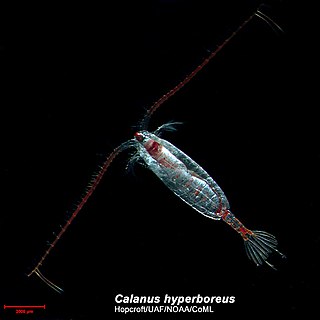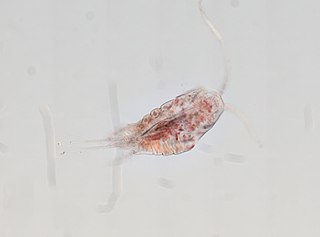
The helmet jellyfish, sometimes called the merchant-cap, is a luminescent, red-colored jellyfish of the deep sea, belonging to the order Coronatae of the phylum Cnidaria. It is the only species in the monotypic genus Periphylla and is one of the rare examples in Scyphozoa which life-cycle lacks a polyp stage. This species is photophobic and inhabits deeper parts of the oceans to avoid light. It may be found at the surface on dark nights.
Karen Frances Wishner is an American oceanographer currently at University of Rhode Island and an elected fellow of the American Association for the Advancement of Science. Her interests include coastal shelf and zooplankton behavior and environment, and has published her findings.

Calanus hyperboreus is a copepod found in the Arctic and northern Atlantic. It occurs from the surface to depths of 5,000 metres (16,000 ft).
Calanus glacialis is an Arctic copepod found in the north-western Atlantic Ocean, adjoining waters, and the northwestern Pacific and its nearby waters. It ranges from sea level to 1,800 metres (5,900 ft) in depth. Females generally range from about 3.6 to 5.5 millimetres in length, and males generally range from about 3.9 to 5.4 millimetres in length.
Calanus helgolandicus is a copepod found in the Atlantic, from the North Sea south to the western coast of Africa. The female has an average size of about 2.9 millimetres (0.11 in) and the male has an average size of about 2.7 millimetres (0.11 in).
Calanus pacificus is a species of copepod found in the Pacific Ocean. The female has an average length of about 3.1 millimetres (0.12 in), and the male has a value of about 2.9 millimetres (0.11 in).
Calanus propinquus is a copepod found in Antarctica, and the surrounding waters.

Calanoides acutus is a copepod found in Antarctica and the surrounding waters.
Metridia longa is a copepod found in the Arctic, the north Atlantic, the Pacific, and surrounding waters. The female has an average length of about 4.2 millimetres (0.17 in), and the males have an average length of about 3.5 millimetres (0.14 in).
Neocalanus plumchrus is a large species of copepod found in the Pacific and Arctic Oceans. It was described in 1921 H. by Marukawa. N. flemingeri was formerly considered as conspecific, likely as a form, until it was split in 1988 by Charles B. Miller.
Neocalanus cristatus is a species of copepod found primarily in the northern Pacific.
Metridia pacifica is a copepod found in the north Pacific and surrounding waters.
Pseudocalanus newmani is a copepod found in Arctic and northern Pacific waters. It was described by Frost in 1989. It is found in the Arctic and surrounding waters. There are multiple generations. Unlike some copepods, P. newmani undergoes reverse diel vertical migration, descending during the night, and ascending during the day, although it may undergo normal or no migration at all depending on predation. This copepod is primarily herbivorous.
Rhincalaus nasutus is a copepod in the family Rhincalanidae.

Temora stylifera is a copepod primarily found in the Atlantic and surrounding waters.
Pseudocalanus elongatus is a copepod found primarily in the Atlantic Ocean.

The lipid pump sequesters carbon from the ocean's surface to deeper waters via lipids associated with overwintering vertically migratory zooplankton. Lipids are a class of hydrocarbon rich, nitrogen and phosphorus deficient compounds essential for cellular structures. This lipid carbon enters the deep ocean as carbon dioxide produced by respiration of lipid reserves and as organic matter from the mortality of zooplankton.
Pseudocalanus minutus is a small copepod found in the Arctic Ocean and surrounding waters.
Longipedia is a genus of marine copepods of the family Longipediidae, order Canuelloida.

Ann Bucklin is Professor Emeritus of Marine Sciences at the University of Connecticut known for her work using molecular tools to study zooplankton. Bucklin was elected a fellow of the American Association for the Advancement of Science in 1995.





